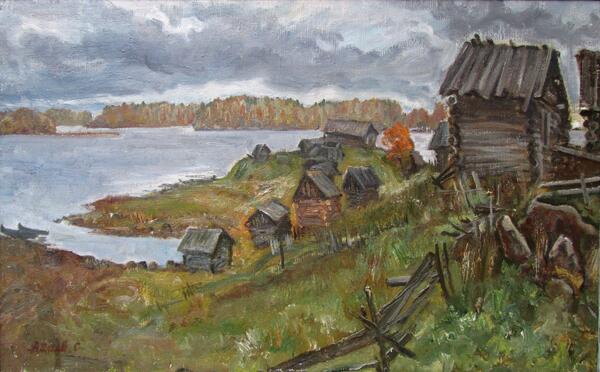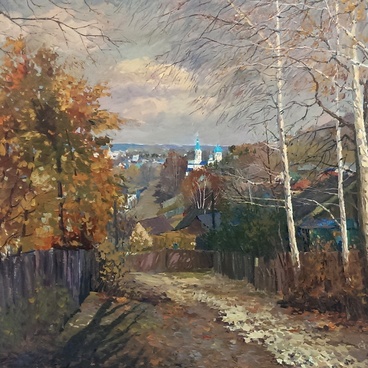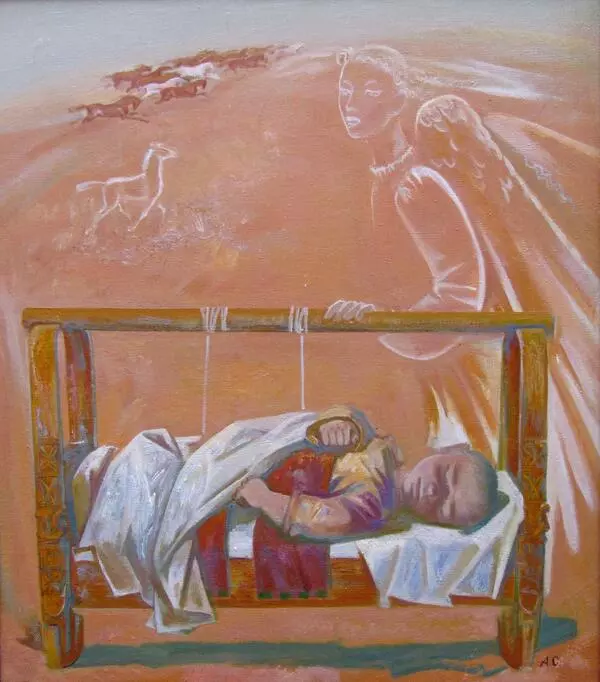The painting “Karelia” was created by Sultan Abaev, a Chechen artist. The artist depicted eight one-story buildings in the center of the canvas, enclosed by a wooden fence. All houses are very small, with no windows. Most likely, they are barns and bathhouses, as typical Karelian izbas (traditional dwellings) had two floors and were cut from round logs and often decorated with carved beams and paintings.
As a rule, the izbas were built straight on the ground, only small stones were placed beneath the corners. They were never located by the road, instead they were built near a lake or a river, surrounded by other izbas, barns and bathhouses.
The oldest huts did not have chimneys (the so called kurnaya izba), which means that they were heated by a stove. Later, stone or wattle and daub furnaces were used instead: the smoke went out through a hole in the ceiling or a wall and through the windows. Soot from the smoke left black traces on the walls — hence, it was called heating the izba “in the black way”. In the 12th century, chimneys appeared, and the huts began to be heated “in the white way”.
A lake is depicted in the background, Abaev painted an autumn forest on its shores. The sky is gloomy with dark clouds. The small village looks abandoned. Abaev preserved its historical appearance. The color scheme chosen by the artist conveys the atmosphere of the area where the Karelians have been living for several centuries.
When creating the painting, Sultan Abaev drew on the images of Karelia that had already been culturally popular. Karelia is called the land of noisy pines and spruces, the kingdom of water and stone, the land of endless forests and white nights. Picturesque landscapes of Karelia attract not only artists, but also many Russian moviemakers. Over the years, more than 20 movies were shot there. The most famous ones include “The Dawns Here Are Quiet”, “The Cold Summer of 1953”, “And Trees Grow on Stones Too”, “Love and Pigeons”, “The Island”, “Hunting Piranha”, and many more.
Sultan Abaev is a member of the Artists’ Union of St. Petersburg and the Chechen Republic as well as the Artists’ Union of Russia. He was born in 1954. He was fond of drawing since childhood. Abaev studied at the Grozny Art Studio and an art school at the end of the 1960s. He graduated from the Makhachkala Art School in 1978, and in 1987 — from the Ilya Repin Institute of Painting, Sculpture and Architecture.
Nowadays, Abaev works in the studio that belonged to the famous artist Vasily Vereshchagin. Moreover, he teaches and participates in social activities. His paintings are housed in private collections in Germany, China, the United States, Poland, Japan and other countries.
As a rule, the izbas were built straight on the ground, only small stones were placed beneath the corners. They were never located by the road, instead they were built near a lake or a river, surrounded by other izbas, barns and bathhouses.
The oldest huts did not have chimneys (the so called kurnaya izba), which means that they were heated by a stove. Later, stone or wattle and daub furnaces were used instead: the smoke went out through a hole in the ceiling or a wall and through the windows. Soot from the smoke left black traces on the walls — hence, it was called heating the izba “in the black way”. In the 12th century, chimneys appeared, and the huts began to be heated “in the white way”.
A lake is depicted in the background, Abaev painted an autumn forest on its shores. The sky is gloomy with dark clouds. The small village looks abandoned. Abaev preserved its historical appearance. The color scheme chosen by the artist conveys the atmosphere of the area where the Karelians have been living for several centuries.
When creating the painting, Sultan Abaev drew on the images of Karelia that had already been culturally popular. Karelia is called the land of noisy pines and spruces, the kingdom of water and stone, the land of endless forests and white nights. Picturesque landscapes of Karelia attract not only artists, but also many Russian moviemakers. Over the years, more than 20 movies were shot there. The most famous ones include “The Dawns Here Are Quiet”, “The Cold Summer of 1953”, “And Trees Grow on Stones Too”, “Love and Pigeons”, “The Island”, “Hunting Piranha”, and many more.
Sultan Abaev is a member of the Artists’ Union of St. Petersburg and the Chechen Republic as well as the Artists’ Union of Russia. He was born in 1954. He was fond of drawing since childhood. Abaev studied at the Grozny Art Studio and an art school at the end of the 1960s. He graduated from the Makhachkala Art School in 1978, and in 1987 — from the Ilya Repin Institute of Painting, Sculpture and Architecture.
Nowadays, Abaev works in the studio that belonged to the famous artist Vasily Vereshchagin. Moreover, he teaches and participates in social activities. His paintings are housed in private collections in Germany, China, the United States, Poland, Japan and other countries.




